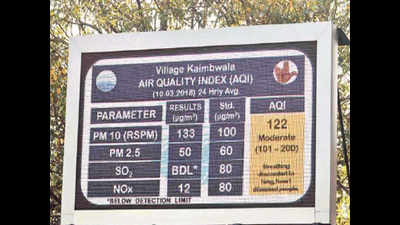- News
- City News
- chandigarh News
- UT to do away with manual collection of air pollution data
Trending
This story is from August 21, 2019
UT to do away with manual collection of air pollution data
he Chandigarh administration has decided to do away with the system of manual collection of data of air pollution in the city. On the lines of real-time air quality monitoring system recently installed in Sector 25, Panjab University, the UT has decided to install a similar system in three more areas - Sector 26, 17 and Industrial Area in the city.

UT has decided to install real-time air quality monitoring system in Sectors 26 and 17 and Industrial Area
CHANDIGARH: The Chandigarh administration has decided to do away with the system of manual collection of data of air pollution in the city. On the lines of real-time air quality monitoring system recently installed in Sector 25, Panjab University, the UT has decided to install a similar system in three more areas - Sector 26, 17 and Industrial Area in the city.
Track the pollution level in your city
The UT administration had installed the Continuous Ambient Air Quality Monitoring Station (CAAQMS) at Sector 25, Panjab University, which was inaugurated by Punjab governor-cum-UT administrator V P Singh Badnore on July 16.The station is providing information regarding the ambient air quality, along with individual readings of eight parameters.
Apart from this system, the UT collects data manually and send it to the Central Pollution Control Board (CPCB) after 24 hours. The Chandigarh Pollution Control Committee (CPCC) measures the level of pollution aftre it installed air quality monitoring devices at four locations, one each at Punjab Engineering College, Sector 12; IMTECH, Sector 39; Industrial Area and one for Kaimbwala village and Sector 17 covering institutional area, industrial zone, rural area and commercial areas, respectively.
Recently, the Union government had set up a target for reduction of pollution. Thereafter the UT administration had decided to prepare a comprehensive action plan. Chandigarh is in the list of 100 cities identified on the basis of level of pollutants such as NO2, PM2.5 and PM10 by the central government for reduction of pollution level. The government aims at cutting pollution level by 35% in the next three years and 50% by the next five years.
Track the pollution level in your city
The UT administration had installed the Continuous Ambient Air Quality Monitoring Station (CAAQMS) at Sector 25, Panjab University, which was inaugurated by Punjab governor-cum-UT administrator V P Singh Badnore on July 16.The station is providing information regarding the ambient air quality, along with individual readings of eight parameters.
Apart from this system, the UT collects data manually and send it to the Central Pollution Control Board (CPCB) after 24 hours. The Chandigarh Pollution Control Committee (CPCC) measures the level of pollution aftre it installed air quality monitoring devices at four locations, one each at Punjab Engineering College, Sector 12; IMTECH, Sector 39; Industrial Area and one for Kaimbwala village and Sector 17 covering institutional area, industrial zone, rural area and commercial areas, respectively.
At present, the local administration does not have any data to quantify proportion of various elements to the overall level of pollution.The officials maintained that dust, crop harvesting seasons, effects of pollens due to greenery, temperature effect, industrial surroundings and vehicular density are the main reasons behind high pollution.
Recently, the Union government had set up a target for reduction of pollution. Thereafter the UT administration had decided to prepare a comprehensive action plan. Chandigarh is in the list of 100 cities identified on the basis of level of pollutants such as NO2, PM2.5 and PM10 by the central government for reduction of pollution level. The government aims at cutting pollution level by 35% in the next three years and 50% by the next five years.
End of Article
FOLLOW US ON SOCIAL MEDIA











